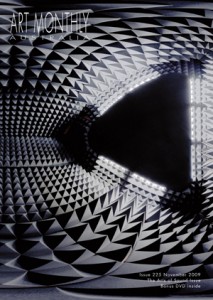The image embracing the exterior of the November issue of Art Monthly Australia (AMA) is the interior of an anechoic chamber, a room designed to create the (rather superficial human) construct of ‘silence’ through its elimination of external environmental noise such as echo, radio frequency and acoustic sounds.

Art Monthly Australia, Issue 225 - The Arts of Sound Edition, November 2009
An anechoic chamber seems a peculiar visual preface to an issue entirely dedicated to the Arts of Sound. However, this gesture of silence is aptly allegorical; it’s a poetic pause button, a poignant cue, and akin to the periods of ‘rest’ or ‘silence’ employed in musical compositions. In this instance the anechoic interior signifies the necessary transitional ‘silence’ required to (re)orient and wholly appreciate the noise within these pages.
The anechoic chamber on the cover has far greater resonance than the silence of its interior. It is actually the panoramic nucleus of Telepathy, an installation constructed by artists Joyce Hinterding and David Haines, whose work is consistently concerned with sourcing and utilising hidden energy forces for audio and/or visual means. Their anechoic chamber was partly an exercise in sensory deprivation, challenging the audience to enter, acknowledge, and rediscover the veiled electromagnetic and sonic worlds within themselves and again once outside the chamber.
Also embedded in the Telepathy work are references to social agency, performative and sculptural practices. It is distinctly interdisciplinary, and such interdisciplinarity is emblematic of the many artists, works and ideas discussed in this issue. Sound, like the complex world around us, is an intrinsic part of the works discussed. However, it should also be noted that such arts of sound practices, more often than not, oscillate between the music/performance and visual/media arts practice areas.
When ANAT received funding from the Australia Council for the Arts Music Board to instate the Embracing Sound [ES] program in mid-2006, it was rather momentous: two national cultural organisations were formally recognising the Australian sound art community and its prevalence within the domains of media arts and music. Such recognition, while affirming the vibrancy of the sound arts sector, also acknowledged the need for enhanced sustainability through formalising broader networks. Whilst many Australian sound arts practitioners are held in high international regard, they are relatively unknown in Australia’s contemporary arts sector. The siting therefore of this special Arts of Sound publication endeavours to consciously contextualise sound art practices within the wider and well-established contemporary arts arena.
A major aspect of recent media arts theory has been the emphasis on the need for media arts to be considered within its interdisciplinary intercultural contexts, rather than the traditional modernist functions and methodologies applied to historicisation and canonisation in art history. Douglas Kahn has been an international leader in contextualising auditory practices within 20th century arts theory, and more recently an underlying thesis of his work has been ‘… one that rewrites the history of communications technologies in terms of nature in order to account for artistic and musical activities from the 1960s to the present’.[1] With such a sustained and rigorous focus, together with the respect Douglas’s writings have already demonstrated for Australian practitioners, it is entirely fitting that we utilised Douglas’s influence as a guest editor. Far from being a parochial editorial process, this publication amplifies many distinctly different viewpoints from Australian and New Zealand writers and artists.
ANAT and AMA wholly thank Douglas for his tireless dedication and informed input to this publication. With the majority of the dialogue and editing process being trans-hemispherical (Australia, New Zealand and USA), this project required an above and beyond level of commitment. AMA editor Maurice O’Riordan is to be congratulated for bravely accepting and following through with the challenge I posed to him in 2008, which was somewhat of a paradigm shift for AMA. Australia Council for the Arts Music Board and the Visual Arts Board’s International Strategies Review provided the core funding support to bring this issue, its complementary DVD featuring four commissioned works along with additional previously published material by Australian artists, and Douglas’s lecture tour into fruition. Particular thanks go the venues hosting Douglas during this lecture tour; TURA New Music, Western Australian Academy of Performing Arts @ Edith Cowan University, The Edge @ State Library of Queensland, Queensland University of Technology, National Film and Sound Archive, Museum of Contemporary Art and our media partners Sound Travellers.
Finally our gratitude must be emphatically expressed to the artists and writers involved in the publication. Without them we would all be suffering from sensory deprivation.
Sarah Last
Sarah is an artist and independent curator who based herself in regional NSW for the past eight years. Since 2003, she’s curated experimental sound and media arts projects for the artist-run-initiative Wagga Space Program and a range of publicly funded organizations. Along with her ES responsibilities, Sarah is currently a PhD candidate with Queensland University of Technology.
References
[i] Statement by Douglas Kahn for an ANAT media release, October 2009.
Read More
http://www.abc.net.au/classic/newmusic/
 This work is licensed under a Creative Commons Attribution-NonCommercial-ShareAlike 2.5 Australia.
This work is licensed under a Creative Commons Attribution-NonCommercial-ShareAlike 2.5 Australia.






